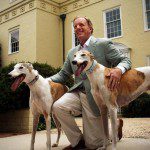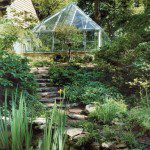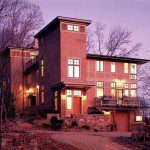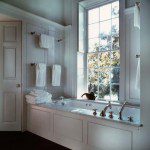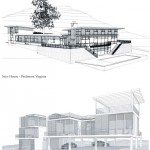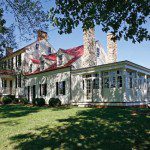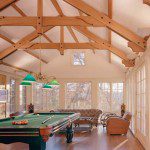Outerbridge Horsey: An Architect of Georgetown
By • May 3, 2012 0 9096
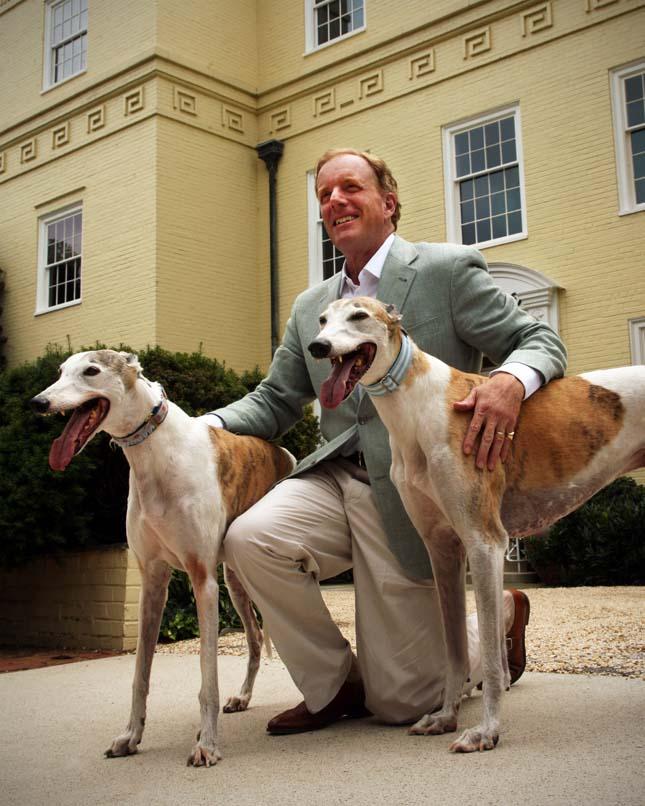
The name Outerbridge Horsey sounds more like an honorific title than the personal name of a tall, red-headed Georgetown resident who is fond of his job, community, wife and two greyhounds. Yet its bearer, who is the seventh in his family to inherit his name, seems to think little of it, other than the fact that people find it easy to remember. Horsey’s is a well-known name throughout the neighborhood; he is an active and passionate member of the community and is the principal of a Georgetown-based architecture and design firm, Outerbridge Horsey Associates, PLLC.
The firm specializes mostly in residential additions remodeling around the D.C. area, although they do some institutional work. Horsey estimates that he has worked on 15 to 20 houses in Georgetown itself but his work is scattered around the east coast – his most recent project was the remodeling of a house in Nantucket.
Samantha: So what first drew you to architecture?
Outerbridge: I grew up abroad. I grew up in Japan, Italy, Rome, Prague, Czechoslovakia and Sicily. And so I think that laid the foundation. Then when I went to college, my first year of college, I was a classics, Greek and archaeology major. I’d been on archeological digs for a continuous two summers and enjoyed it tremendously; I studied Greek in high school. But when I got to college I found that archaeology in the classroom was not nearly as interesting as it was in the field and I fairly quickly, my first year in fact, migrated over to the architecture program called Designing the Environment at Penn, the University of Pennsylvania, and went on from there.
And then I came back here, I majored in design in the environment – it’s just sort of a mixture of landscaping and architecture, landscape design. And then came back here for a year, took some classes at Georgetown and applied to architecture schools and ended up back at Penn again for my master’s degree. So it’s worked out very well. But I have a feeling all that exposure to, especially in Italy, to beautiful buildings and ruins and even archaeology, sort of, was the foundation.
S: And why have you continued doing it?
O: Because I love it. I’ll never be rich, but that’s okay, I’m rich in loving what I do and I think that’s the most important thing. My wife, fortunately, is interested it and appreciates it and tolerates my love for it. I get up every day and I love to do what I do every day, most of it anyway. And it’s great, you know, there’s always something new. Every client, every site, every project, doing something new so it’s never dull. Not to say there aren’t some tedious times running a business and making sure the little details are attended to by the builders and all that, but the whole process is really pretty enjoyable from the beginning, meeting the client, to seeing the project through construction to finalizing the details and seeing the building emerge. So, it’s fun.
S: What has your favorite project been that you’ve worked on and why?
O: Well, the house in Nantucket is certainly the most memorable one…well, there have been several, actually. The house in Nantucket and the complete redo of a Watergate apartment. I’d never worked on the renovation of an apartment, I’d only worked on new apartments. The house in Nantucket was great because it’s a fairly tight regulatory review process […] so they start very early in providing parameters for new buildings throughout the island in Nantucket. It’s very fortunate that the entire island, I believe, is governed by the town council and all the building departments and so on and so forth – all their regulations apply all over the island.
They started in the 70s and they wrote this book called “Building with Nantucket in Mind,” which basically lays out all the dos and the don’ts and the cans and the can’ts, and it’s really quite helpful. But within that there’s a great deal of flexibility that you can work with, but that sort of gives you the vocabulary. Everything has to be natural, white shingled, and it all works, you can see why they did it.
Have you ever been to Nantucket? I’d never been before three years ago, but all the house sizes are different and there are certain parts of the island that are very dense, but there’s a sort of, not homogeneity, but, nothing jumps out at you, which is important. Other places you go, houses are very different, paint colors are very different, the materials are very different, the aesthetic style is very different, and it can be somewhat discordant. And Nantucket’s not like that. So that was interesting to work within those parameters and working with the Historic District Commission was interesting, it went pretty well, actually, surprisingly, and in the end they thought very highly of the design which I took as a compliment. […]
S: What was your vision for your firm when you first opened it, and have you lived up to that dream or has it changed?
O: I was trained as a modernist at Penn and at the time I came out there was very little modern architecture even in D.C. But the training I had, I guess you could call it a classical training in architecture, and we were both familiar with architectural design and the history of architecture. […] But I ended up, when I went to work in Philadelphia for a year and I came back here knowing I wanted to start my own firm and I worked for a couple of firms doing my apprenticeship for three years.
I think the vision I had was just designing beautiful buildings without any particular emphasis on style or period, design. Traditional architectural design tends to have a stylistic period that they sort of focus on, but I like almost all of them, all the architectural periods and styles, so I’m less concerned about being particular to any one. So designing in a variety of styles and designing some modern buildings has ended up what we’ve done and I’ve been very pleased with that. You know, I’d be nice to do a little bit more modern work and we actually are doing a little bit more now, which is nice. I think the vision is pretty much the same.
It’d be fun to design my own house some time, but I haven’t quite gotten there, I’m not sure that’ll happen. I think every architect wants to design their own house, some are lucky enough to do it, others aren’t.
S: And speaking of your house, you are a Georgetown resident. What do you like or dislike about the neighborhood?
O: I love the area. My wife has lived her whole life in Georgetown so that’s been important but my parents moved here in the early 70s and I was in high school at the time just going to college, so I didn’t really live here the whole time. I came back here for the summers and enjoyed it immensely but I didn’t really live here full time till the early 80s when I came back from architecture school. And I’ve always lived in Georgetown, my jobs have always been in Georgetown. When I worked for other firms, they were both located in Georgetown.
I like the river, I like the parks, I think it’s a pretty remarkable environment in that it offers something, a lot of diversity, to people of all ages. Children to teenagers to young professionals to older people. I think it’s the sense of community, village-like atmosphere. In those days there were a lot more stores that catered to the neighborhood than there are now and that was a nice aspect that has been lost, I think, which is too bad. But what we gained in exchange for that is more vitality in the commercial district, which I think is important, there were always doors shuttered in the old days. And that wasn’t a blight, but there’s a much more vibrant commercial district and that’s good for the community, good for the city, it brings people from the city into our neighborhood which is good too.
When we first were married my first house was up the street here, 31st and N, and our whole sort of outlook was towards the river, walking down there, and we moved five blocks about six years ago, we moved to the north to 32nd between Q and R, and our whole focus sort of changed. It’s now at the parks on the north end of Georgetown, plus we got two dogs so that kind of encouraged that interest in the parks.
S: You’re also a very active member of the Georgetown community.
O: I have been at times, it’s true.
S: And what compels you to speak up, so to say?
O: What compels me to get involved? I guess it’s a disposition, a personal disposition I have. It probably runs in my family to do something for one’s community or public service in some way even though I have my own firm I guess I’m just personally inclined to want to participate and want to help and give the necessary time.
S: What kinds of projects have you spoken up for in the past? You were just featured in the Georgetowner speaking about the Tudor Place and everything going on there.
O: That’s right, I’m trying to find what’s best for Tudor Place in the neighborhood. But I guess the early things that I was involved in, probably the most meaningful ones, were the Georgetown Ministry Center where I was involved for many years. I was president of the board for four years at the very early stages so that was very interesting, it was very much needed, it still is needed and they’re doing a fabulous job now. […]
And the other early initiative was Trees for Georgetown which I helped to start along with two other people, Flow Stone is still around and very involved with various things in the community and Ann Witherspoon who is now living in California. And the need at that time was that the District of Columbia had no money at all for their tree replacement program. Their funds were completely dry, the nursery was empty, and the tree maintenance division of the government was really down to a skeleton staff. And they had the whole city to deal with, so we started to raise money to plant trees and worked hard at it. We got contractors working in concert with the government and it was very successful, we raised enough money to plant empty tree boxes every year. […]
There are other things, I was on the Citizen’s Association Board for five years, so there was a period when I was very involved.
S: But not so much anymore?
O: I did get involved with another board downtown for five years which took a lot of my time but now I’m back focusing on my practice which needs me more than ever in these trying times.
- Outerbridge Horsey | Philip Bermingham
- Provided by Outerbridge Horsey Associates, PLLC
- Provided by Outerbridge Horsey Associates, PLLC


